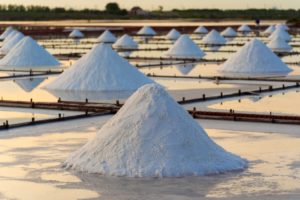Applications & Advantages of Molten Salt in Heating Systems
Last updated on May 6th, 2025 at 03:47 am
Molten salts are melted minerals used in various heating applications. Nitrate salts are the most common, although bromides, chlorides, fluorides, and even organic salts are used for this purpose. They are capable of operating under versatile temperatures and conditions, making them ideal for many heating applications.
This article examines the key advantages and applications of molten salts in heating systems.
Advantages of Molten Salt Melts
Operating Temperatures
In comparison with other heat transfer fluids, molten salts offer a much greater operating temperature range. Salts increase their maximum temperature limits and have lower operating temperatures.
Salts, particularly nitrate salts, have low melting points. Lower melting points result in a lower risk of freezing, as well as allowing use at lower temperatures. To further reduce melting points, two salts can be combined.
For example, sodium nitrate has a melting point of 307℃ and potassium nitrate’s melting point is 333℃. But, when the two salts are combined, their salt blend has a melting point of 222℃. This allows the salt melt to be used at temperatures where natural oil-based transfer fluids begin to degrade.
Furthermore, molten salts excel in high temperatures. While even expensive synthetics oils can only operate at temperatures up to 390℃, molten salts are capable of temperatures exceeding 600℃.
The typical operating temperature range of molten salt transfer fluids is from 285℃ to 565℃. However, using fluoride and chloride salts can allow for higher temperature applications.
Low Vapor Pressure
In comparison with synthetic oils, molten salts transfer fluids experience minimal vapor pressure, even when operating at high temperatures. As a result, expensive high-pressure piping and equipment are often unnecessary.
Add in that salts like sodium nitrate create minimal corrosion risk, and salt melts are great for equipment maintenance and longevity.
Efficiency
Molten salts have good thermal stability and demonstrate excellent heat transfer properties. As a result, they are efficient, eco-friendly, and have low operating costs.
Also read: Molten Salt as Heat Transfer Fluid
Molten Salt Heating Applications
Thermal Fluid Heating
One of the most common applications of molten salts is thermal fluid heating. As discussed in the advantages section, molten salt thermal fluids are ideal for high-temperature applications. At temperatures where oil transfer fluids begin to break down causing inefficiency, equipment damage, and fouling, molten salts pose no such problem.
Considering their efficiency and low vapor pressure, molten salt transfer mediums are ideal for thermal fluid systems, so long as they operate at least 20℃ to 30℃ above their melting point.
Thermal Storage
Another common use of salt melts is in thermal storage. They have excellent thermal stability and heat transfer capability. These thermal properties make molten salts ideal for energy storage. For example, they are increasingly used in concentrated solar plants.
Solar plants have long had issues with storing energy. Because they can only operate while the sun is out, they cannot produce energy 24/7. Storage issues meant any excess energy that could not be used or sold to the grid was lost.
Using immersion water heaters in solar power systems helps to alleviate this challenge, making storage a possibility. By leveraging the thermal properties of molten salts, even greater energy storage is possible. As a result, they are making solar power more efficient and increasing its capability.

